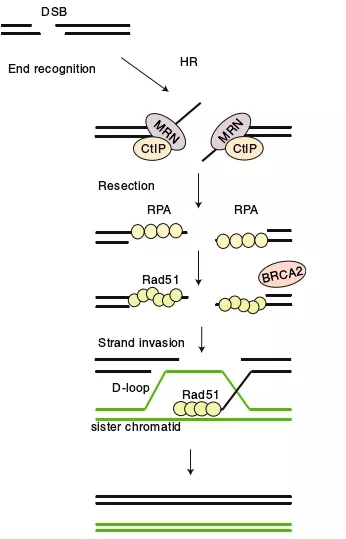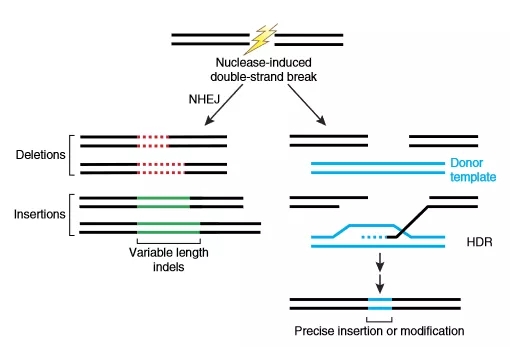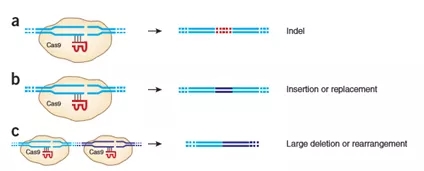[Dry goods] save your injured DNA-NHEJ and HR
Life is extremely fragile. Under the influence of endogenous factors such as electronic radiation, ultraviolet rays, haze and other external environments and cell metabolites, the core of our life, DNA, will be damaged to varying degrees, among which DNA double-strand breaks ( DSBs, Double Strand breaks) are the most serious of the damage, but life is extremely powerful, we are always injured, and we are self-healing all the time. So what mechanism does our body use to repair DNA damage? And listen to us slowly~
For DSBs injury, there are mainly non-homologous end joining (NHEJ) and homologous recombination (HR) . Single-strand annealing repair generally occurs in tandem homologous DNA sequences. [1] (Figure 1). The following small series will give you a detailed introduction to how the daily body can repair and repair our injured DNA through these two ways.

Figure 1. DSBs repair path
Alternative path of DNA double-strand break repair. Homologous recombination is the preferred route in yeast. It involves invasion of the broken DNA strands into a homologous DNA duplex molecule. This process requires Rad52 (a DNA end-binding protein), Rad51 (which Forms filaments along the unwound DNA strands), DNA polymerases and other less well-characterized gene products. The DNA ends are ligated by DNA ligase I and the interwound DNA strands are separated, probably by another protein complex, with no loss of genetic information. Only one of many possible recombination products is shown here. Single-strand annealing takes place between two homologous DNA sequences in tandem (yellow and orange boxes) by a less well-studied mechanism. It also requires Rad52, and extensive degradation of the two unannealed Strands results in considerable loss of genetic material. Nonhomologous end joining rejoins the two broken ends directly. It requires the DNA end-binding protein Ku which, in ma Mlalian cells, forms a complex with DNA-PKcs(red). Other steps in this process involve the Rad50–Mre11—Nbs1 complex in mammals (which may also be involved in homologous recombination, at least in yeast) and the XRCC4—DNA ligase IV complex. Few, or no, bases are missing from the products of nonhomologous end joining.
Non-homologous end link-NHEJ
NHEJ is a simple and sturdy and efficient way to repair, broken? Manage it three seven twenty-one, hurry up! It’s this temper!

NHEJ: I am tempered! [6]
It is a repair process that directly links the ends of DSBs by DNA ligase, independent of homologous DNA sequences. The Ku protein (Ku70/Ku80) complex recognizes and binds to the end of DSBs. The Ku-DNA complex recruits a DNA-dependent protein kinase catalytic subunit (DNA-PKcs) to activate its kinase activity, and autophosphorylation initiates the NHEJ pathway, attracting the recombinase Artemis. Add DNA to the ends of the DNA, then call XRCC4-DNAligase4 -XLF complex to facilitate DNA ligation [2].
NHEJ's temper is quick and efficient, but it has a series of side effects, which may cause some sequence missing, and also cause some fragments to be inserted, which is called inaccurate.

Figure 2. NHEJ
Rapid association of Ku to DSBs promotes NHEJ by recruiting DNA-PKcs. Sequential phosphorylation events on multiple DNA-PKcs amino acid clusters favors the initial processing of DNA ends by ARTEMIS, followed by DNA-PKcs-dependent protection of DNA ends required for DNA ligation .
Homologous recombination-HR
HR is another Virgo-style pursuit of nostalgia and perfect repair: I want to find myself! No more than one! One can't be less!

HR: I am so perfect! [7]
HR requires a homologous sequence of uninjured sister chromatids as a template for its repair. The MRN complex recognizes DSBs and binds to the DNA end. The first step in repairing is to trim the DNA ends. The MRN complex and the transcription factor CtIP (CtBP-interacting protein) promote DNA end-cleavage, resulting in degradation of the 5' end DNA. 3' single-stranded DNA (ssDNA), 3' ssDNA is coated with replication protein A (RPA) to protect it from nuclease degradation, remove secondary structure; then mediated by BRCA2 protein, RPA is recombined The enzyme RAD51 is replaced to form a nuclear protein filament to find homologous sequences on sister chromatids, RAD51 protein mediates invasion of DNA double-stranded templates, pairing with homologous DNA sequences to form D-Loop structures, D-Loop extensions or with the other end Connect to complete the repair process [3] .

Figure 3. HR
The MRN-CtIP-complex starts resection on the breaks to generate single stranded DNA (ssDNA). After resection the break can no longer be repaired byNHEJ. The ssDNA is first coated by RPA, which is subsequently replaced by Rad51 with the help of BRCA2 These Rad51 nucleoprotein filaments mediate strand invasion on the homologous template. Extension of the D-loop and capture of the second end lead to repair.
HR obsessive-compulsive repair, although slower, less efficient, but accurate, can make the genome perfect repair, as good as ever!
After this introduction, everyone should have a preliminary impression of our DNA double-chain repair partners?
In short, their characteristics are: NHEJ repair is fast and inaccurate , and several bases may be randomly introduced and removed during the process, and the whole cell cycle occurs, playing an important role in G1 and S phases; The repair of HR is complex and precise , but requires a homologous sequence template that can only occur in the G2/S phase of the cell. The NHEJ or HR repair mechanism is selectively activated against different types of DSBs to rescue the injured DNA.
Having said that, do you have a deeper understanding of the DNA repair mechanism? Only by mastering the study can you better apply it.
Learn to use
With the in-depth study and interpretation of these two repair methods, this repair mechanism has been gradually applied to gene editing technology for targeted genetic modification. The researchers used nuclease technology to cause the DNA double-strand to be purposefully cleaved, using this mechanism to regulate the expression of the target gene or introduce a selectable marker.
In the absence of a template, NHEJ repair, random insertion or deletion of bases cause gene inactivation; in the presence of a template, the target modification gene can be introduced at the cleavage site by homologous recombination to achieve targeted knocking of the gene. Go to [4] (Figure 4).

Figure 4. Nuclease-induced genome editing
Nuclease-induced double strand breaks (DSBs) can be repaired by nonhomologous end joining (NHEJ) or homology-directed repair (HDR) pathways. Imprecise NHEJ mediated repair can produce insertion and/or deletion mutations of variable length at the site of the DSB HDR-mediated repair can introduce precise point mutations or insertions from a single-stranded or double stranded DNA donor template.
Taking CRISPR/Cas9 technology as an example, as shown in Figure 5a, Cas9 protein cleaves DNA double strands to form DSBs. Using NHEJ repair mechanism, random deletion or insertion of bases causes frameshift mutation, and the target gene is knocked out. In Figure 5b, the cleavage simultaneously introduces a foreign gene, which NHEJ will access to the DSBs site for gene insertion. In Fig. 5c, the cleavage sites are respectively set at both ends, the middle fragment is free, and the two ends are connected by NHEJ mechanism to form a large fragment gene knockout [4] .

Figure 5. (a,b) gRNA-directed Cas9 nuclease can induce indel mutations (a) or specific sequence replacement or insertion (b). (c) Pairs of gRNA-directed Cas9 nucleases can stimulate large deletions or genomic rearrangements (eg, Inversions or translocations).
At the same time of the cleavage, the foreign gene and the homologous sequence are added, and the HR mechanism can realize the precise typing and replacement of the gene. The efficiency of CRISPR/Cas9-mediated NHEJ is much higher than that of HR [5] . How can the perfect HR partner play a greater role in improving the efficiency of our gene knock-in?
In order to achieve efficient and accurate gene-based knock-in, the EGE (Extreme Genome Editing System) system independently developed by Biotase has improved homologous recombination efficiency by nearly 20 times (Fig. 6) , providing a large degree of more precise editing. The possibility of genes!

Figure 6. EGE (Extreme Genome Editing System) system independently developed by Biotase
Biotech has many years of experience in preparing gene knockouts and knocking into large mice. Professional technical team, teachers who need to prepare, please contact us through the contact information below.
references:
1. Featherstone, C., & Jackson, SP (1999). DNA double-strand break repair. Current Biology, 9(20), R759–R761.
2. Ciccia, A., & Elledge, SJ (2010). The DNA Damage Response: Making It Safe to Play with Knives. Molecular Cell, 40(2), 179–204.
3.Brandsma, I., & Gent, DC (2012). Pathway choice in DNA double strand break repair: observations of a balancing act. Genome Integrity, 3(1), 9.
4.Sander, JD, & Joung, JK (2014). CRISPR-Cas systems for editing, regulating and targeting genomes. Nature Biotechnology, 32(4), 347–355.
5.Ma, Y., Chen, W., Zhang, X., Yu, L., Dong, W., Pan, S., ... Zhang, L. (2016). Increasing the efficiency of CRISPR/Cas9-mediated Precise genome editing in rats by inhibiting NHEJ and using Cas9 protein. RNA Biology, 13(7), 605–612.
6.https://
7.http://
 Injection Device
Syringes can also call Disposable Medical Supplies, Disposable Syringe With Needle and Plastic Needle Tube such as some scientific instruments in chromatography to inject through the rubber septum. Injecting gas into a blood vessel will cause an air embolism. The way to remove air from the syringe to avoid embolism is to turn the syringe upside down, tap it lightly, and squeeze out a little bit of fluid before injecting into the bloodstream.
In some cases where accuracy is not the primary concern of germs, such as quantitative chemical analysis, glass syringes are still used due to the small error of the glass syringe and the smooth movement of the push rod.
You can also inject some of the juices into meat with a syringe to improve taste and texture while cooking, or into pastries when baking. Syringes can also fill ink cartridges with ink.
Injection Device,Intravenous Infusion Set,Iv Infusion Sets,Blood Pressure Monitor
Haloxylon Ammodendron Medical Equipment Co., Ltd. , https://www.ssmedicaldevic.com